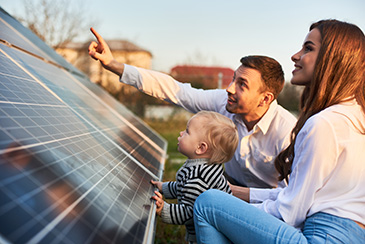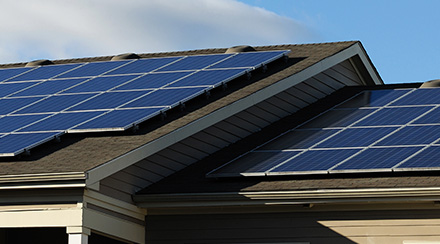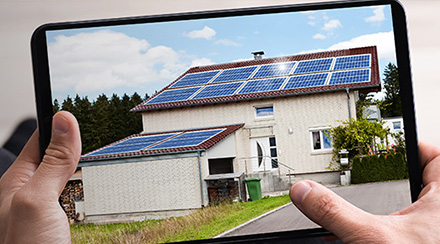How Do Solar Panels Work?

Rooftop solar panels are among the most visible symbols of a new energy future that is cleaner, healthier and more renewable. But do you know how solar panels work?
While the technology that goes into a solar panel is state-of-the-art, the overall design concept is rather simple.
How Does Solar Energy Work?
The light produced by the sun is electromagnetic radiation, a renewable source of energy that falls freely to the earth. The amount of solar energy that reaches us every day is tremendous, and solar panels take a small amount of that energy and convert it into electricity for our homes and businesses.
Solar panels aren’t the only tools we use to convert solar energy into electricity, but they’re the most common, especially in residential areas. They make use of technologies we call photovoltaics, or PV.
A PV solar panel contains several interconnected solar cells. Solar cells are extremely thin and made primarily of silicon, but they also contain separate layers that are treated with chemicals that affect the flow of electricity. One layer is treated with phosphorus, which helps generate a negative electrical charge, and the other layer is treated with boron, which helps generate a positive electrical charge. These layers are separated by a thin layer of metal, which conducts electricity and forms a circuit through which it can freely flow.
When electromagnetic radiation falls from the sun onto a solar cell, the silicon acts as a semiconductor and absorbs the energy. The opposite charges of the two layers of silicon draw electrons out of the particles of sunlight, which flow through the circuit as electricity.
In most PV solar installations, multiple solar panels are wired together in what is called a solar array. This connects all of the individual solar cells together, creating a large circuit that leads to a component called an inverter. Electricity from the cells flows to the inverter as direct current (DC), and the inverter converts it to an alternating current (AC), which is the type of electricity that flows through our household wiring.
How Solar-Generated Electricity is Used

Once the inverter has converted the electricity to AC, it can flow to one of three places: the home’s electrical panel, the main electrical grid or a home battery.
When the electricity flows into the home’s electrical panel, it’s used to power the home’s appliances and systems for free. When it flows into the main electrical grid, it becomes part of the general electricity supply we all share, and it’s calculated as a credit – essentially, the home is “selling” electricity back to the electrical utility. And when the electricity flows into a home battery, it’s stored so that it can be used to power the home during a power outage or during periods of peak energy demand.
A home battery is not required as part of a residential solar installation, but when they’re installed, the electricity generated by the solar panels usually flows to the battery first until the battery is full. After that, the electricity typically flows into the home’s electrical panel and is consumed on-site. If there’s still excess electricity that is not being consumed by appliances and home systems, that electricity then flows into the main electrical grid.
In a home with solar panels but no home battery, the solar-generated electricity will typically flow into the electrical panel first, with any excess flowing into the grid. During a power outage, the solar panels will still generate electricity that can be used in the home, but this is dependent on the amount of available sunshine. In order to have a reliable supply of emergency energy, it’s helpful to have a home battery that can provide a steady flow of electricity day or night.
There are other common applications of PV solar panel technology, such as solar generators. With these products, the solar panels work the same as in a rooftop solar installation, but the inverter and battery are contained in a single portable generator that can be carried around to produce clean electricity on-the-go.
PV technology is undergoing constant research and development, with engineers working to make solar cells more efficient, compact and durable. So while we primarily associate solar power with the rigid solar panels we see installed on rooftops, we can expect to see more solar cells on vehicles, consumer electronics and even flexible fabrics in the near future.
Looking for Something Specific?
Select a category to find resources for topics that interest you.
Select Category

Related Articles:

What Is Solar Energy and How Does it Work?
Thanks to rapidly advancing technology, a growing share of our energy comes from renewable sources like wind, hydropower and solar. Learn about solar energy and how it provides for homes and communities.
Read Article
The Different Types of Solar Panels
When deciding what type of solar panel is best for your home, it’s worth taking the time to weigh the pros and cons of each panel type against your budget, climate and energy needs.
Read Article
How Much Do Solar Panels Cost?
All solar installations are customized based on the size, design and energy needs of the home, so there is no one-size-fits-all price. Let’s review the basic factors that affect the cost of solar installation.
Read ArticleHow Do Solar Panels Work?
Rooftop solar panels are among the most visible symbols of a new energy future that is cleaner, healthier and more renewable. But do you know how solar panels work?
While the technology that goes into a solar panel is state-of-the-art, the overall design concept is rather simple.
How Does Solar Energy Work?
The light produced by the sun is electromagnetic radiation, a renewable source of energy that falls freely to the earth. The amount of solar energy that reaches us every day is tremendous, and solar panels take a small amount of that energy and convert it into electricity for our homes and businesses.
Solar panels aren’t the only tools we use to convert solar energy into electricity, but they’re the most common, especially in residential areas. They make use of technologies we call photovoltaics, or PV.
A PV solar panel contains several interconnected solar cells. Solar cells are extremely thin and made primarily of silicon, but they also contain separate layers that are treated with chemicals that affect the flow of electricity. One layer is treated with phosphorus, which helps generate a negative electrical charge, and the other layer is treated with boron, which helps generate a positive electrical charge. These layers are separated by a thin layer of metal, which conducts electricity and forms a circuit through which it can freely flow.
When electromagnetic radiation falls from the sun onto a solar cell, the silicon acts as a semiconductor and absorbs the energy. The opposite charges of the two layers of silicon draw electrons out of the particles of sunlight, which flow through the circuit as electricity.
In most PV solar installations, multiple solar panels are wired together in what is called a solar array. This connects all of the individual solar cells together, creating a large circuit that leads to a component called an inverter. Electricity from the cells flows to the inverter as direct current (DC), and the inverter converts it to an alternating current (AC), which is the type of electricity that flows through our household wiring.
How Solar-Generated Electricity is Used
Once the inverter has converted the electricity to AC, it can flow to one of three places: the home’s electrical panel, the main electrical grid or a home battery.
When the electricity flows into the home’s electrical panel, it’s used to power the home’s appliances and systems for free. When it flows into the main electrical grid, it becomes part of the general electricity supply we all share, and it’s calculated as a credit – essentially, the home is “selling” electricity back to the electrical utility. And when the electricity flows into a home battery, it’s stored so that it can be used to power the home during a power outage or during periods of peak energy demand.
A home battery is not required as part of a residential solar installation, but when they’re installed, the electricity generated by the solar panels usually flows to the battery first until the battery is full. After that, the electricity typically flows into the home’s electrical panel and is consumed on-site. If there’s still excess electricity that is not being consumed by appliances and home systems, that electricity then flows into the main electrical grid.
In a home with solar panels but no home battery, the solar-generated electricity will typically flow into the electrical panel first, with any excess flowing into the grid. During a power outage, the solar panels will still generate electricity that can be used in the home, but this is dependent on the amount of available sunshine. In order to have a reliable supply of emergency energy, it’s helpful to have a home battery that can provide a steady flow of electricity day or night.
There are other common applications of PV solar panel technology, such as solar generators. With these products, the solar panels work the same as in a rooftop solar installation, but the inverter and battery are contained in a single portable generator that can be carried around to produce clean electricity on-the-go.
PV technology is undergoing constant research and development, with engineers working to make solar cells more efficient, compact and durable. So while we primarily associate solar power with the rigid solar panels we see installed on rooftops, we can expect to see more solar cells on vehicles, consumer electronics and even flexible fabrics in the near future.
Looking for Something Specific?
Select a category to find resources for topics that interest you.
Select Category

Related Articles:

What Is Solar Energy and How Does it Work?
Thanks to rapidly advancing technology, a growing share of our energy comes from renewable sources like wind, hydropower and solar. Learn about solar energy and how it provides for homes and communities.
Read Article
The Different Types of Solar Panels
When deciding what type of solar panel is best for your home, it’s worth taking the time to weigh the pros and cons of each panel type against your budget, climate and energy needs.
Read Article
How Much Do Solar Panels Cost?
All solar installations are customized based on the size, design and energy needs of the home, so there is no one-size-fits-all price. Let’s review the basic factors that affect the cost of solar installation.
Read Article






